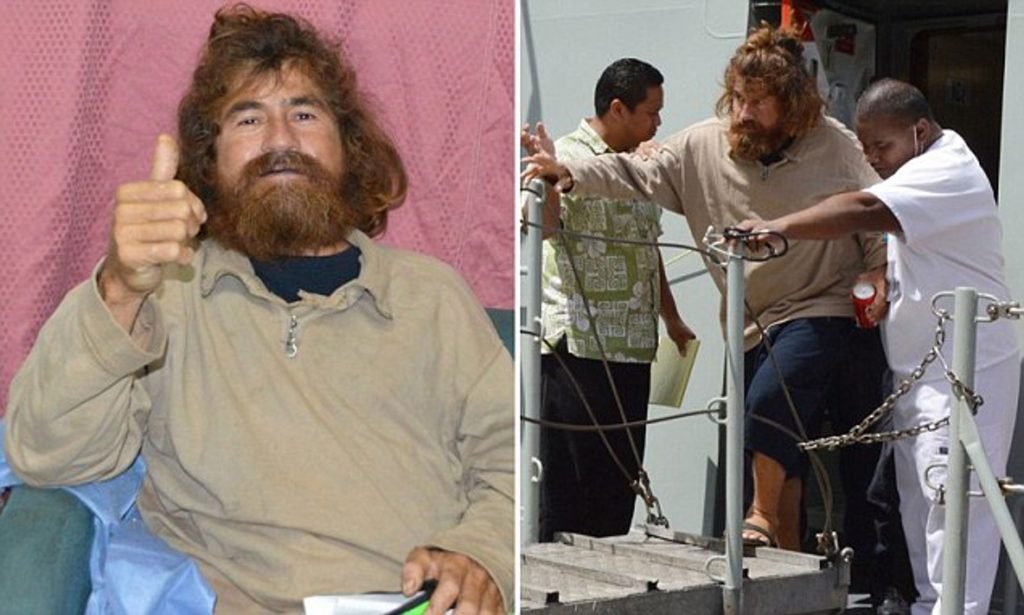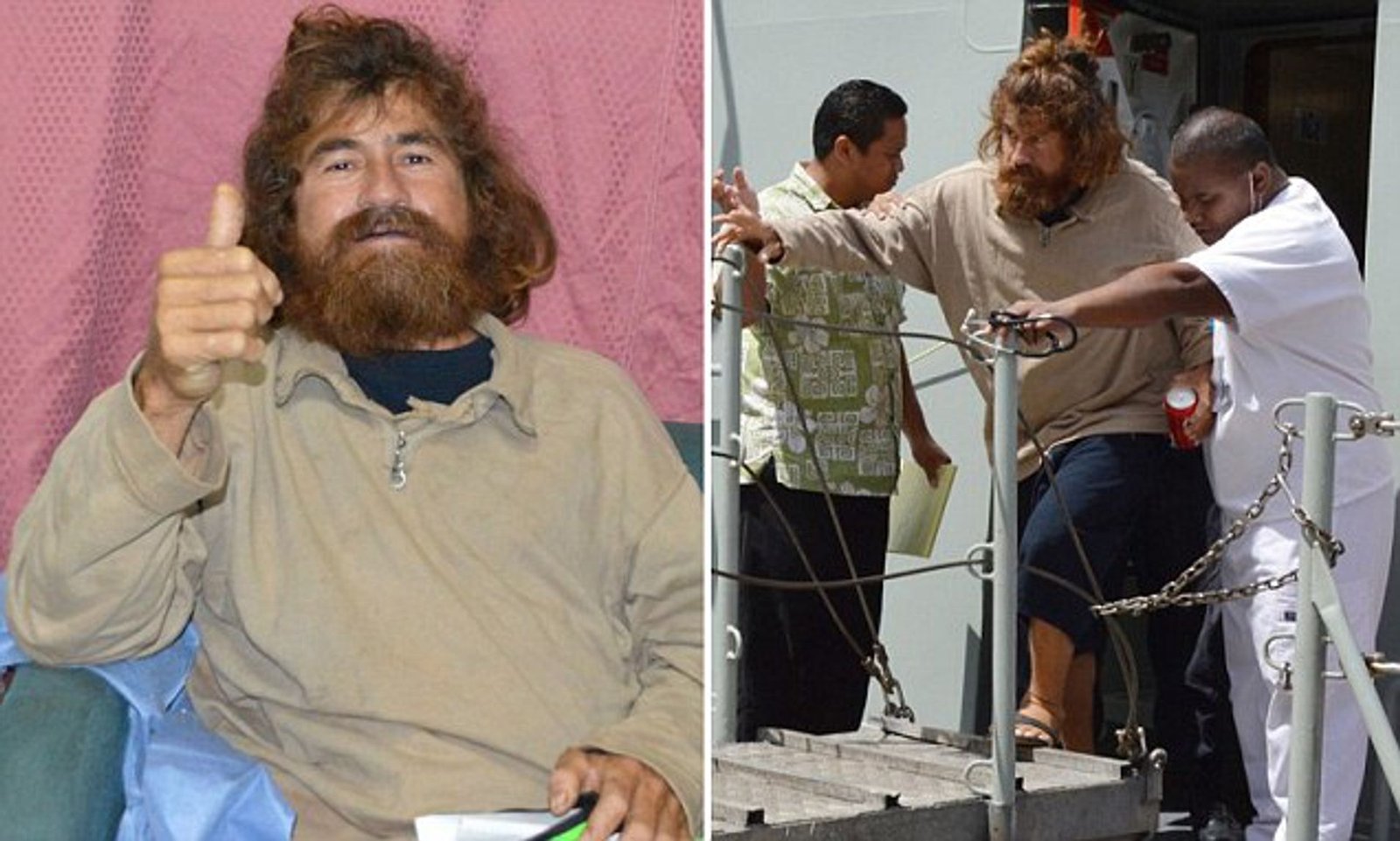
José the morning afterhis arrival on Ebon (Epoon), weary and worn out. Foto: Ione De Brum, Mayor of Ebon Atoll)
While not actually holding the record for the longest drift at sea, José Salvador Alvarenga holds the recordord for the longest solo-drift at sea, with a staggering 438 days. That’s ‘only’ 46 days less than the longest drift ever, which ended sometime in 1815 (from the Tokyo area to southern California). However, that was in a freighter and they started off with a large crew. Alvarenga’s feat was much more stunning.

Working as a shark fisher in Costa Azul, off the coast of Chiapas, Mexico, José and his helper for the day, Ezequiel Córdoba, were caught in a storm on November 17, 2012. Unfortunately, their motor broke down, and the radio equipment failed. The two men went off the grid, unable to reach help. Alvarenga and Córdoba were stuck in a 25 feet fiberglass boat, with a non-functioning engine, and very little equipment left — they had even smoked their last bud and eaten all of their pancakes.
(Note written by Alvarenga shortly after his arrival on Ebon. Foto: Ola G. Berta, anthropologist.)
I’ll be brief about Alvarenga’s drift at sea. I strongly urge interested readers towards Jonathan Franklin’s excellent book, 438 days: An Extraordinary True Story of Survival at Sea.
Sadly, Córdoba passed away after having drifted for about two or three months. He had at one point eaten a contaminated bird, something which resulted in strong aversions against raw meat. Coupled with depression, his difficulty in eating eventually caused his body to break down until he one day passed away. Desperate not to be left alone, Alvarenga kept his deceased friend aboard the boat for at least six days after his passing, still making conversations with him and still preparing his food for him.
During his time at sea, Alvarenga developed his hunting skills, snatching birds that landed on the rim of his boat, fishing with his hands and with a wire he extracted from the broken outboard engine, and grabbing sea turtles as they surfaced near his boat. He had times of abundance, and he had times of scarcity. When it rained, he managed to store water in whatever container he had on his boat, but he would also resort to drinking turtle blood and even urine in times of desperation.
Finally, after 438 days at sea, Alvarenga reached Tile Islet on Ebon Atoll, in the southern Marshall Islands, on January 29, 2014. Having crossed the reef barrier, he abandoned his boat and swam ashore.
(Ebon Atoll. Tile Islet is that tiny dot on the eastern side of the atoll, directly south of the islet named as Eninaitok. Truly a Gary Larson size islet.)
Tile is a tiny islet, and therefore uninhabited. On the islet to its north, Eninaitok, however, lives a nice couple, Amy and Russel. They live there more or less permanently to produce copra (dried coconut meat). Luckily for Alvarenga, they were there when he arrived. Hearing his calls for help, they managed to wade across the reef to bring him back to their home. Once there, they fed, washed, and clothed him. Amy also explained that she was accustomed to ‘white people’s’ custom of hugging each other, so she did just that: Gave Alvarenga a great, big hug.
(Amy and Russel posing with Alvarenga before departure to the main islet. The man in white is a local police officer. Photo: Ione De Brum.)
Amy and Russel sent for help, bringing with them a hand-written note from José (see photo above). Back on the main islet, also called Ebon, the Mayor summoned a group of people to go pick him up — in the council’s own 25 feet fiberglass boat. This group of people included myself, as I was living on Ebon at the time as part of a social anthropological fieldwork (my last name was Fjeldstad back then, but I’ve since married and taken my wife’s name).
(Alvarenga’s boat, Camaroneros de la Costa. Photo: Ione De Brum.)
(Inside his boat. In addition to this turtle, his food supply consisted of a few dead birds, some turtle scraps, and a live baby bird. Photo: Ione De Brum.)
Back on Ebon, it took quite some time and effort to get the communication going. Alvarenga was weary, introvert, and immensely scared. He later explained that he had been dreadfully paranoid, feeling that he was kept hostage throughout his stay on Ebon, which lasted about four days (he even tried to escape once, only to meet one of his ‘wardens’ at the bottom of the stairs). With no Spanish speakers on the atoll, and no effort on Alvarenga’s behalf to communicate with signs and pantomime, it was difficult to get anything out of him the first hours of his stay.
After having eaten heartily and having consumed several fresh coconuts, Alvarenga finally managed to communicate by drawing and pantomime. The story we unraveled was remarkably close to what has later been verified. We knew that he had drifted from the coast of Mexico, that he had been accompanied by a younger man named Ezequiel, that he had passed away after a couple of months, and that his boss’ name was Willy. What we got wrong, however, was the length of his time at sea. We had though he left around Christmas, 2012, which meant about 13 months earlier. That’s why early media reports gave that number. As it turns out, his story was even more remarkable, with a staggering 14,5 months at sea, about a year of that time alone. Moreover, José, for reasons unknown, decided to present himself as José Ivan to us, a name still kept alive among Ebon people.
(A page from my note book in which we tried to unravel his story. The car and the airplane with a cross over was our way of telling him that ‘Sorry, man, there’s no way out of here — you’re still way out on the ocean.)
(Trying to communicate the first night of his arrival. The room was full of people that entire night. Though not unprecedented, it’s not an everyday occurrence that people drift ashore on Ebon. Photo: Ola G. Berta.)
José was terrified to learn that. even though he had reached land, he was still a long way from global interconnection. With no internet, no available airplanes, and no other means for transportation at hand, he would still have to wait a few days before he could begin his travel back home. On his fourth day on Ebon, the national police finally arrived with a ship, ready to take him back to Majuro, the nation’s capital. Unbeknownst to us, his story had gone viral during his stay there (I had phoned a local journalist in the capital, Giff Johnson, a few days earlier in an attempt to get the government’s attention, as they declined our call for help on the grounds of not believing us). In other words, José was not prepared for the media circus that met him when he docked in Majuro.
(José making his way aboard the Majuro bound ship. Photo: Ola G. Berta.)
It was amazing to see how he gradually regained his strength and vigor during the few days he spent on Ebon. People came by all the time (he stayed with me in the local council house) to give him food, clothes, and freshly peeled coconuts. We used to sit outside in the shade, eating and listening to music, mostly Dylan and a Norwegian folk singer called Ole Paus. We didn’t say much, but José put his hands together from time to time, looked up at the sky, and said a few words of thank you to his (newfound) god. He would also smile to himself at the sounds of chickens walking about outside, sometimes exclaiming ‘pollo!’ with a satisfied look on his face.
(José posing with a brand new pair of underwear, the cause for much laughter in the room. Photo: Ola G. Berta.)
There you have it. The record for the longest solo-drift, lost at sea ever is held by José Salvador Alvarenga, to some better known as José Ivan.
(Quiet meditation over how things turned out. José mainly kept inside except for a few quiet moments outside on the veranda, listening to music and to children playing on the path. Photo: Ola G. Berta.)



